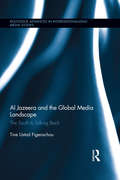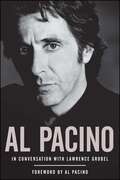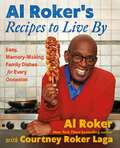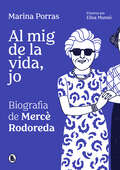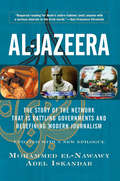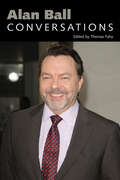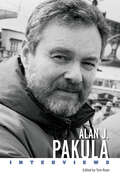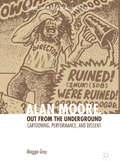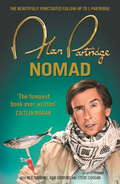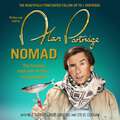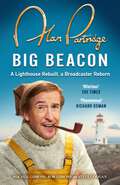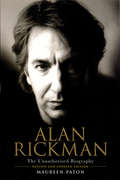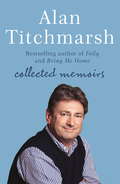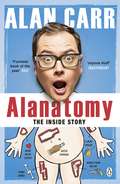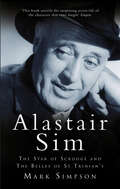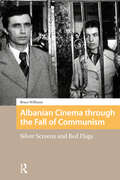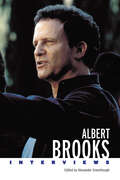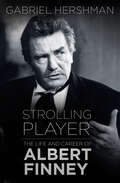- Table View
- List View
Al Jazeera and the Global Media Landscape: The South is Talking Back (Routledge Advances in Internationalizing Media Studies)
by Tine Ustad FigenschouThis book analyzes how and why Al Jazeera English (AJE) became the channel of choice to understand the massive protests across the Arab world 2011. Aiming to explain the ‘Al Jazeera moment,’ it tracks the channel’s bumpy road towards international recognition in a longitudinal, in-depth analysis of the channel’s editorial profile and strategies. Studying AJE from its launch in mid-November 2006 to the ‘Arab Spring’, it explains and problematizes the channel’s ambitious editorial agenda and strategies, examines the internal conflicts, practical challenges and minor breakthroughs in its formative years. The Al Jazeera-phenomenon has received massive attention, but it remains under-researched. The growth of transnational satellite television has transformed the global media landscape into a complex web of multi-vocal, multimedia and multi-directional flows. Based on a combination of policy-, production- and content analysis of comprehensive empirical data the book offers an innovative perspective on the theorization of global news contra-flows. By problematizing the distinctive characteristics of AJE, it examines the strategic motivation behind the channel and the ways in which its production processes and news profile are meant to be different from its Anglo-American competitors. These questions underscore a central nexus of the book: the changing relationship between transnational satellite news and power.
Al Pacino: The Authorized Biography
by Lawrence GrobelFor more than a quarter century, Al Pacino has spoken freely and deeply with acclaimed journalist and bestselling author Lawrence Grobel on subjects as diverse as childhood, acting, and fatherhood. Here, for the first time, are the complete conversations and shared observations between the actor and the writer; the result is an intimate and revealing look at one of the most accomplished, and private, artists in the world.Pacino grew up sharing a three-room apartment in the Bronx with nine people in what he describes as his "New York Huckleberry Finn" childhood. Raised mostly by his grandparents and his mother, Pacino began drinking at age thirteen. Shortly after he was admitted to the renowned High School for Performing Arts, his classmates nicknamed him "Marlon," after Marlon Brando, even though Pacino didn't know who Brando was. Renowned acting coach Charlie Laughton saw Pacino when he was nineteen in the stairwell of a Bronx tenement, and the first words out of Laughton's mouth were "You are going to be a star." And so began a fabled, lifelong friendship that nurtured Al through years of not knowing where his next meal would come from until finally -- at age twenty-six -- he landed his first salaried acting job. Grobel and Pacino leave few stones unturned, touching on the times when Pacino played piano in jazz clubs until four a.m. before showing up on the set of Scarecrow a few hours later for a full day's work; when he ate Valium like candy at the Academy Awards; and when he realized he had been in a long pattern of work and drink. As the pivotal character in The Godfather trilogy and the cult classic Scarface, Pacino has enshrined himself in film history. He's worked with most of Hollywood's brightest luminaries such as Francis Ford Coppola, Sidney Lumet, Michael Mann, Norman Jewison, Brian De Palma, Marlon Brando, Robert De Niro, Gene Hackman, Sean Penn, Johnny Depp, Michelle Pfeiffer, Hilary Swank, and Robin Williams, among many others. He was nominated for eight Academy Awards before winning the Oscar for Best Actor for his role in Scent of a Woman. Pacino still seems to prefer his work onstage to film and, if he's moved by a script or play, is quick to take parts in independent productions. Al Pacino is an intensely personal window into the life of an artist concerned more with the process of his art than with the fruits of his labor, a creative genius at the peak of his artistic powers who, after all these years, still longs to grow and learn more about his craft. And, for now, it's as close to a memoir as we're likely to get.
Al Roker’s Recipes to Live By: Easy, Memory-Making Family Dishes for Every Occasion
by Al Roker Courtney Roker LagaBarnes & Nobles Most Anticipated Comfort Food BooksTODAY Show cohost and America&’s favorite weatherman, Al Roker, and his daughter, Courtney Roker Laga, welcome us into their kitchen in this cookbook featuring generations-long family favorites for every meal. Al Roker and his daughter, Courtney Roker Laga, welcome you into their home, where a good conversation or a needed dose of laughter always starts with something great to eat. 100 original and kitchen-tested dishes for every occasion, including Sunrise Burritos Shrimp and Grits with Bell Peppers and Bacon Smothered Chicken Coffee- and Spice-Rubbed Pork Chops Christmas Morning Cinnamon Rolls Bourbon Apple Pie Milkshakes Tuscan Polenta Silky Cauliflower Puree Lemon Meringue Crumb Crust Pie Stunning dishes in this book will inspire you to start cooking memory-making meals. Full of cheerful family photos and Al&’s frank, witty opinions on food and cooking, Al Roker&’s Recipes to Live By is sure to become the most well-thumbed cookbook on your shelf, whether you&’re a beginner home cook or a seasoned chef.
Al mig de la vida, jo
by Marina PorrasLa biografia sobre l'autora més influent de la literatura catalana des de la mirada fresca i revel·ladora de Marina Porras, periodista i crítica literària La vida de Mercè Rodoreda és la conquesta de la individualitat que es necessita per escriure. De nena va ser educada per ser una esposa convencional, de jove aspirava a ser una periodista del sistema i dues guerres la van fer créixer i descobrir de cop el món del segle XX. De l'estricta supervivència al descobriment de la solitud, Rodoreda va entendre que només se salvaria a través de l'escriptura si els seus llibres rescataven la memòria del seu temps. Marina Porras, periodista i crítica literària, explica en aquest retrat biogràfic la manera com es lliguen la vida i l'obra de l'escriptora més influent de la literatura catalana. La infantesa a la Barcelona d'abans de la guerra, la joventut a l'exili francès, la vida parisenca, l'esclat artístic a Ginebra i els anys finals a Romanyà.Una biografia fresca i directa amb il·lustracions de Elisa Munsó.
Al-Jazeera: The Story of the Network that is Rattling Governments and Redefining Modern Journalism
by Mohammed El-Nawawy Adel IskandarAl-Jazeera, the independent, all-Arab television news network based in Qatar, emerged as ambassador to the Arab world in the events following September 11, 2001. Arabic for "the island," Al-Jazeera has "scooped" the western media conglomerates many times. With its exclusive access to Osama Bin Laden and members of the Taliban, its reputation was burnished quickly through its exposure on CNN. During the 2003 war in Iraq, Al-Jazeera seemed to be everywhere, reporting dramatic stories and images, even as it strived to maintain its independence as an international free press news network. Al-Jazeera sheds light on the background of the network: how it operates, the programs it broadcasts, its effects on Arab viewers, the reactions of the West and Arab states, the implications for the future of news broadcasting in the Middle East, and its struggle for a free press and public opinion in the Arab world.
Alain Resnais: Interviews (Conversations with Filmmakers Series)
by T. Jefferson KlineAmong the most innovative and influential filmmakers of the twentieth century, Alain Resnais (1922–2014) did not originally set out to become a director. He trained as an actor and film editor and, during the sixty-eight years of his working life, delved into virtually every corner of filmmaking, working at one time or another as screenwriter, assistant director, camera operator and cinematographer, special effects coordinator, technical consultant, and even author of source material. From such award-winning documentaries as Van Gogh and Night and Fog to the groundbreaking dramas Hiroshima mon amour, Last Year at Marienbad, and Muriel, Resnais’s films experiment with such themes as consciousness, memory, and the imagination. Distinguishing himself from associations with the French New Wave movement, Resnais considered his films to be “anti-illusionist,” never allowing his spectators to forget they were watching a work of art. In Alain Resnais: Interviews, editor Lynn A. Higgins collects twenty-one interviews with the filmmaker, twelve of which are translated into English for the first time. Spanning his entire career from his early short subjects to his final feature film, the volume highlights Resnais’s creative strategies and principles, illuminates his place in world cinema history, and situates his work relative to the New Wave, American film, and experimental filmmaking more broadly. Like his films, the interviews collected here reveal a creator who is at once an intellectual, a philosopher, an entertainer, a craftsman, and an artist.
Alan Ball: Conversations (Television Conversations Series)
by Thomas FahyAlan Ball: Conversations features interviews that span Alan Ball's entire career and include detailed observations and insights into his Academy Award-winning film American Beauty and Emmy Award-winning television shows Six Feet Under and True Blood. Ball began his career as a playwright in New York, and his work soon caught the attention of Hollywood television producers. After writing for the sitcoms Grace Under Fire and Cybill, Ball turned his attention to the screenplay that would become American Beauty. The critical success of this film opened up exciting possibilities for him in the realm of television. He created the critically acclaimed show Six Feet Under, and after the series finale, he decided to explore the issue of American bigotry toward the Middle East in his 2007 play All That I Will Ever Be and the film Towelhead, which he adapted and directed in the same year. Ball returned to television once again with the series True Blood—an adaptation of the humorous, entertaining, and erotic world of Charlaine Harris’s vampire novels. In 2012 Ball announced that he would step down as executive producer of True Blood, in part, to produce both a new television series and his screenplay, What’s the Matter with Margie?
Alan Bennett: A Critical Introduction (Studies in Modern Drama)
by Joseph O'MealyAlan Bennett is perhaps best known in the UK for the BBC production of his Talking Heads TV plays, while the rest of the world may recognize him for the film adaptation of his play, The Madness of King George. O'Mealy points out that Bennett is a social critic strongly influenced by Beckett and Swift, interested in depicting and analyzing the role playing of everyday life, a'la sociologist Ervin Goffman.
Alan J. Pakula: Interviews (Conversations with Filmmakers Series)
by Tom RyanRenowned for his masterful storytelling, Alan J. Pakula (1928–1998) left an indelible mark on cinema history. Alan J. Pakula: Interviews offers a concise yet comprehensive overview of the director’s illustrious career, from his early days in Hollywood to his rise as a major filmmaker. From the famous “paranoia trilogy” of Klute, The Parallax View, and All the President’s Men to the gripping psychological drama of Sophie’s Choice and his often-undervalued later work, Pakula’s diverse filmography has captivated audiences and critics alike. The first published collection of interviews with the acclaimed director, this volume presents an illuminating portrait of Pakula as a filmmaker, an artist, and a man of many parts. The eighteen pieces compiled here, including an illuminating introduction and previously unpublished 1983 interview by editor Tom Ryan, provide a broad overview of Pakula’s career. In his own words, Pakula recounts his experience as Robert Mulligan’s producer, reflects on the bulk of films he made as director, and outlines his approach to the art of filmmaking. Taken as a whole, Alan J. Pakula: Interviews is a treasure trove of cinematic wisdom and a fitting tribute to the legacy of an important American filmmaker.
Alan Moore, Out from the Underground: Cartooning, Performance, and Dissent (Palgrave Studies in Comics and Graphic Novels)
by Maggie GrayThis book explores Alan Moore's career as a cartoonist, as shaped by his transdisciplinary practice as a poet, illustrator, musician and playwright as well as his involvement in the Northampton Arts Lab and the hippie counterculture in which it took place. It traces Moore's trajectory out from the underground comix scene of the 1970s and into a commercial music press rocked by the arrival of punk. In doing so it uncovers how performance has shaped Moore's approach to comics and their political potential. Drawing on the work of Bertholt Brecht, who similarly fused political dissent with experimental popular art, this book considers what looking strangely at Alan Moore as cartoonist tells us about comics, their visual and material form, and the performance and politics of their reading and making.
Alan Partridge: Nomad
by Alan PartridgeAs seen on This Time with Alan Partridge on BBC One. THE SUNDAY TIMES BESTSELLERPraise for Nomad: 'Funniest book of the year' Sunday Telegraph'Alan Partridge's Nomad is almost certainly the funniest book ever written' Caitlin Moran'Sensationally funny. What brilliant writing' Richard Osman'Sensational' Jenny Colgan'Hilarious' Jon Ronson'Brilliantly funny' Marcus BrigstockIn ALAN PARTRIDGE: NOMAD, Alan dons his boots, windcheater and scarf and embarks on an odyssey through a place he once knew - it's called Britain - intent on completing a journey of immense personal significance.Diarising his ramble in the form of a 'journey journal', Alan details the people and places he encounters, ruminates on matters large and small and, on a final leg fraught with danger, becomes - not a man (because he was one to start off with) - but a better, more inspiring example of a man. This deeply personal book is divided into chapters and has a colour photograph on the front cover. It is deeply personal. Through witty vignettes, heavy essays and nod-inducing pieces of wisdom, Alan shines a light on the nooks of the nation and the crannies of himself, making this a biography that biographs the biographer while also biographing bits of Britain.
Alan Partridge: Nomad
by Alan PartridgeAs seen on This Time with Alan Partridge on BBC One.THE SUNDAY TIMES BESTSELLERPraise for Nomad: 'Funniest book of the year' Sunday Telegraph'Alan Partridge's Nomad is almost certainly the funniest book ever written' Caitlin Moran'Sensationally funny. What brilliant writing' Richard Osman'Sensational' Jenny Colgan'Hilarious' Jon Ronson'Brilliantly funny' Marcus BrigstockIn ALAN PARTRIDGE: NOMAD, Alan dons his boots, windcheater and scarf and embarks on an odyssey through a place he once knew - it's called Britain - intent on completing a journey of immense personal significance.Diarising his ramble in the form of a 'journey journal', Alan details the people and places he encounters, ruminates on matters large and small and, on a final leg fraught with danger, becomes - not a man (because he was one to start off with) - but a better, more inspiring example of a man. This deeply personal book is divided into chapters and has a colour photograph on the front cover. It is deeply personal. Through witty vignettes, heavy essays and nod-inducing pieces of wisdom, Alan shines a light on the nooks of the nation and the crannies of himself, making this a biography that biographs the biographer while also biographing bits of Britain.
Alan Partridge: Nomad
by Alan PartridgeCurrently co-hosting This Time with Alan Partridge on BBC One.THE SUNDAY TIMES BESTSELLERPraise for Nomad: 'Funniest book of the year' Sunday Telegraph'Alan Partridge's Nomad is almost certainly the funniest book ever written' Caitlin Moran'Sensationally funny. What brilliant writing' Richard Osman'Sensational' Jenny Colgan'Hilarious' Jon Ronson'Brilliantly funny' Marcus BrigstockIn ALAN PARTRIDGE: NOMAD, Alan dons his boots, windcheater and scarf and embarks on an odyssey through a place he once knew - it's called Britain - intent on completing a journey of immense personal significance.Diarising his ramble in the form of a 'journey journal', Alan details the people and places he encounters, ruminates on matters large and small and, on a final leg fraught with danger, becomes - not a man (because he was one to start off with) - but a better, more inspiring example of a man. This deeply personal book is divided into chapters and has a colour photograph on the front cover. It is deeply personal. Through witty vignettes, heavy essays and nod-inducing pieces of wisdom, Alan shines a light on the nooks of the nation and the crannies of himself, making this a biography that biographs the biographer while also biographing bits of Britain.
Alan Partridge: The hilarious new memoir from the nation's favourite broadcaster
by Alan Partridge'There are prizes, normally named after PG Wodehouse, given to literary comic novels and non-fiction, and these books will have blurbs saying "hilarious" on them. This is infinitely funnier than any of them' DAVID BADDIEL'The funniest series of books ever written in the English language' RICHARD OSMAN'Hilarious' THE TIMES'Absolute f**king genius' CAITLIN MORAN'With a genuine belly laugh to be found on almost every page, it only cements Partridge's status as the world's greatest comedy character' EMPIRE'Partridge... has become the man our time deserves. Aha!' THE TIMES'This is a deeply silly book. It's also glorious...[with] proper belly laughs on pretty much every page' i NEWS'Every sentence screams pure Partridge...a spoof that comes close to comic genius' DAILY EXPRESS'Expect plenty of laughs' HEAT'Not only has Alan Partridge created an entirely new storytelling structure, it's very funny indeed' JON RONSON In Big Beacon, Norwich's favourite son and best broadcaster, Alan Partridge, triumphs against the odds. TWICE.Using an innovative 'dual narrative' structure you sometimes see in films, Big Beacon tells the story of how Partridge heroically rebuilt his TV career, rising like a phoenix from the desolate wasteland of local radio to climb to the summit of Mount Primetime and regain the nationwide prominence his talent merits. But then something quite unexpected and moving, because Big Beacon also tells the story of a selfless man, driven to restore an old lighthouse to its former glory, motivated by nothing more than respect for a quietly heroic old building that many take for granted, which some people think is a metaphor for Alan himself even though it's not really for them to say.* Leaving his old life behind and relocating to a small coastal village in Kent, Alan battles through adversity, wins the hearts and minds of a suspicious community, and ultimately shows himself to be a quite wonderful man. * The two strands will run in tandem, their narrative arcs mirroring each other to make the parallels between the two stories abundantly clear to the less able reader.
Alan Partridge: The hilarious new memoir from the nation's favourite broadcaster
by Alan Partridge'There are prizes, normally named after PG Wodehouse, given to literary comic novels and non-fiction, and these books will have blurbs saying "hilarious" on them. This is infinitely funnier than any of them' DAVID BADDIEL'The funniest series of books ever written in the English language' RICHARD OSMAN'Hilarious' THE TIMES'Absolute f**king genius' CAITLIN MORAN'With a genuine belly laugh to be found on almost every page, it only cements Partridge's status as the world's greatest comedy character' EMPIRE'Partridge... has become the man our time deserves. Aha!' THE TIMES'This is a deeply silly book. It's also glorious...[with] proper belly laughs on pretty much every page' i NEWS'Every sentence screams pure Partridge...a spoof that comes close to comic genius' DAILY EXPRESS'Expect plenty of laughs' HEAT'Not only has Alan Partridge created an entirely new storytelling structure, it's very funny indeed' JON RONSON In Big Beacon, Norwich's favourite son and best broadcaster, Alan Partridge, triumphs against the odds. TWICE.Using an innovative 'dual narrative' structure you sometimes see in films, Big Beacon tells the story of how Partridge heroically rebuilt his TV career, rising like a phoenix from the desolate wasteland of local radio to climb to the summit of Mount Primetime and regain the nationwide prominence his talent merits. But then something quite unexpected and moving, because Big Beacon also tells the story of a selfless man, driven to restore an old lighthouse to its former glory, motivated by nothing more than respect for a quietly heroic old building that many take for granted, which some people think is a metaphor for Alan himself even though it's not really for them to say.* Leaving his old life behind and relocating to a small coastal village in Kent, Alan battles through adversity, wins the hearts and minds of a suspicious community, and ultimately shows himself to be a quite wonderful man. * The two strands will run in tandem, their narrative arcs mirroring each other to make the parallels between the two stories abundantly clear to the less able reader.
Alan Rickman: The Unauthorised Biography
by Maureen PatonIn this revised and updated biography, Maureen Paton encompasses the private, professional and political life of this most enigmatic, charismatic and intensely private of actors.
Alan Titchmarsh: Trowel and Error, Nobbut a Lad, Knave of Spades
by Alan TitchmarshIn these three bestselling memoirs, Alan tells his own story from Ilkley Moor to Pebble Mill and to the final realising of his dream of becoming TV's favourite gardener. Along the way, the cast of characters includes everyone from Auntie Ethel to Nelson Mandela and the Queen.
Alan Titchmarsh: Trowel and Error, Nobbut a Lad, Knave of Spades
by Alan TitchmarshIn these three bestselling memoirs, Alan tells his own story from Ilkley Moor to Pebble Mill and to the final realising of his dream of becoming TV's favourite gardener. Along the way, the cast of characters includes everyone from Auntie Ethel to Nelson Mandela and the Queen.
Alanatomy: The Inside Story
by Alan Carr***If you loved Alan's first memoir - Look Who It Is! - then his follow-up, Alanatomy, will take you further into the hilarious and bizarre world of the country's favourite chatty man.***'As laugh out loud as his TV shows' Daily MirrorIt must seem strange to you that I've called a book Alanatomy . . . For anyone who has taken the time to see my stand-up performances or watched my chat show, 'Chattyman', knows that my body has hardly been kind to me - in fact there've been times when we've actually stopped talking to each other. Balding, myopic, often flaky with psoriasis, back fat that hangs suspended like a cape, a voice that could strip varnish, an increasingly dodgy hip and even dodgier teeth. Why would you draw attention to it? you must ask. Couldn't you just call the book something else? Do you think the Great British Public is ready to pore over your body? Well, as I turn forty and take stock of my showbiz life over the last ten years or so, I have learnt to embrace my flaws and face my shortcomings. In fact, strange as it might seem, the things I hate about myself have become my trademark and I am slowly, begrudgingly learning to, if not love them, to at least live with them. I am ready now to take a long hard look at myself and that's what Alanatomy is. It's the story of my rise to fame: the joys, the traumas, the parties, the disappointments. Hopefully you will find it witty, fun, heartwarming, but more importantly honest, and that it will keep you entertained every time you pick it up. Alanatomy is the chance for you to get beneath my skin and see the real me because, and to continue the anatomical theme if I may, this showbiz existence can sometimes feel like an autopsy - picked at, probed and scrutinized with every inch of your body held up for analysis, but unlike an actual autopsy, you are very much alive. So I give you Alanatomy: The Inside Story. I am laying myself out on the slab for your entertainment; naked, stripped bare. Grab your scalpel, peel back the skin and go deep, have a good old probe around at my life so far. Yes, you are going to find guts, a fair bit of cheek, maybe even a little bit of gristle, but hopefully, you'll find a whole lot of heart.
Alaska: Los sueños se cumplen... si te animás a ser vos
by Gimena SauchencoEl libro de la youtuber uruguaya más conocida y más querida. En ese libro, Gime, más conocida como Alaska, cuenta su historia, la historia de una adolescente uruguaya como cualquier otra, pero además, reflexiona sobre la vida, cuáles son sus miedos, qué piensa sobre la sociedad, entre otras cosas, que son temas que preocupan y ocupan a los adolescentes de hoy.
Alastair Sim: The Real Belle of St Trinian's
by Mark SimpsonAlastair sim was an energetic character both on and off the screen. His idiosyncratic style of acting in films such as 'The Belles of St Trinian's' endeared him to a cinema-going audience desperate to escape the day-to-day dreariness of an invasive, bureaucratic post-war Britain. In private, he was a curiously contradictory character, prejudiced and yet tolerant, thoughtful but sometimes inconsiderate. to examine the life of this extraordinary man, this biography contains original contributions from around thirty actors and actresses, including Sir Ian McKellen and Ronnie Corbett. It is supported by extensive research, including interviews with the playright Christopher Fry, the television producer John Howard Davies and actors who appeared on stage with Alastair as far back as the 1940s. This book also explore Alastair's life outside of films, including his marriage to Naomi Sim (whom he first met when she was twelve), his career as an elocution teacher, his extensive work on stage (including his theatrical endeavours with James Bridie), his championship of youth and his stalwart refusal to sign autographs.
Albanian Cinema through the Fall of Communism: Silver Screens and Red Flags (Eastern European Screen Cultures)
by Bruce WilliamsAlbanian cinema truly represents a terra incognita for most of the world. Decidedly Europe’s most isolated country during the Cold War era, communist Albania had already been cut off from the West for centuries as a one of the western-most outposts of the Ottoman empire. Nonetheless, and unknown to most of the world, communist Albania had a vibrant cinema tradition. Although bound by official orthodoxy, the films of the state-run Kinostudio enterprise were surprisingly innovative and, at times, daringly subversive. This book opens with examinations of moving images in Albania from the Ottoman period, through those captured under independence and the Fascist occupation. It subsequently foregrounds transformations in Kinostudio, from the early optimism of socialist realism through the brooding social angst of the 1980s, which constitute a bridge to the socioeconomic concerns of Albanian films of the postcommunist period.
Albert Brooks: Interviews (Conversations with Filmmakers Series)
by Alexander GreenhoughAlbert Brooks: Interviews brings together fourteen profiles of and conversations with Brooks (b. 1947), in which he contemplates, expounds upon, and hilariously jokes about the connections between his show business upbringing, an ambivalence about the film industry, the nature of fame and success, and the meaning and purpose of comedy. Throughout all these encounters, Brooks expresses an unwavering commitment to his own artistic expression as a filmmaker and a rejection of mainstream conventions. With his questioning and critical disposition, nothing seems certain for Albert Brooks except for the integrity of art and the necessity for a wry skepticism about the incongruities of everyday life in corporate America. Brooks is neither a Hollywood insider nor an outsider. He’s somewhere in-between. Since the early 1970s, this inimitable actor-writer-director has incisively satirized the mass media system from within. After initial work as an inventive comedian, both live and on network television, Brooks contributed six shorts to the first season of Saturday Night Live, which earned him a cult following for their avant-garde form and sensibility. These were followed by his feature debut, Real Life, the first of only seven films—including Modern Romance, Lost in America, and Defending Your Life—that Brooks has directed to date. His limited output reflects not only the difficulty in financing idiosyncratic films, but equally the exacting seriousness which Brooks has in making audiences laugh and think at the same time.
Albert Finney: A Well-Seasoned Life
by Gabriel Hershman‘Hershman has managed to gather a huge amount of information and distill it into a book that is not only respectful but full of insights into what makes this unstarriest of stars able to produce brilliant work without appearing to break a sweat.’ - Kathryn Hughes, Mail on SundayHe was a Salford-born, homework-hating bookie’s son who broke the social barriers of British film. He did his share of roistering, and yet outlived his contemporaries and dodged typecasting to become a five-time Oscar nominee and one of our most durable international stars. Bon vivant, perennial rebel, self-effacing character actor, charismatic charmer, mentor to a generation of working-class artists, a byword for professionalism, lover of horseflesh and female flesh – Albert Finney is all these things and more.Gabriel Hershman’s colourful and riveting account of Finney’s life and work, which draws on interviews with many of his directors and co-stars, examines how one of Britain’s greatest actors built a glittering career without sacrificing his integrity.
